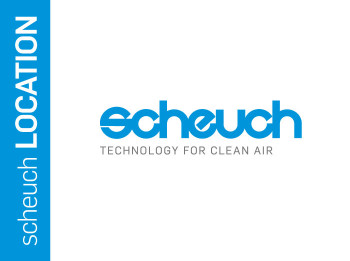DEW – Construction stage 1 successfully completed
Deutsche Edelstahlwerke GmbH (DEW) , Witten (D)
DEUTSCHE EDELSTAHLWERKE GmbH (DEW) is investing some 50 million euros in modifying and modernising a secondary metallurgy centre at its site in Witten, Germany. The new dedusting concept, developed by Scheuch, is designed not only for secondary metallurgy work, but also for tasks involving electric arc furnaces. Once the two construction stages are completed in 2014, the production facilities will be able to boast state-of-the-art technology and offer an environmental protection concept that's fit for the future.
After commissioning a silo plant for the two dedusting systems – designed for temporary storage of separated dust – at the turn of 2011/12, the site saw the first construction stage (EAF dedusting) reach its conclusion in August 2013. This work involved replacing the old electrostatic precipitators with an EMC filter plant and reconnecting the existing gas conditioning tower to this.
“Starting out, we had some exceptionally difficult conditions to work with: the statics of the premises and the building, as well as the task of converting everything within the scheduled downtime, were both real challenges. Where the dedusting plant was concerned, our main focus was on energy efficiency and emission limits – and therefore on the ability to control individual functions, regulate fans and reduce clean gas values in line with the TA Luft regulation. But we also had to work out how to gain a clearer understanding of the existing structure. That put us in a position to make direct contact with suppliers.“
“When we were evaluating various providers, we had some key criteria: reference projects, staff structure, commitment, proximity, and adherence to contract conditions. We needed a supplier who could weave some real magic into the plant they were producing for us – and we weren’t just looking for a good outcome, but a sense of dependability during the project as a whole. After all, exceptional reliability, high efficiency levels, problem-free operation from the outset, and focused performance were all things that we wanted our new dedusting technology to offer. Scheuch’s specific type of staff structure and its basic company structure really stood out to us. When you look at competing suppliers, you often find that engineering firms that arise from former plant construction companies are just think-tanks – manufacturing and installation work are certainly carried out on their behalf, but usually by subcontractors. The fact that Scheuch was able to offer a one-stop shop for production and assembly services, and do it all in house, was definitely the deciding factor.
Right up until just before signing a contract in July 2011 – when we were in the final stages of this process – we weren’t happy with the solutions that had already been proposed. Then the decider came along – Scheuch’s suggested solution. The variable bag lengths, filter housing sizes and funnel shapes in the EMC filter range meant we knew that raw gas connections could be attached at the rear for situations that needed this, and that the clean gas connection could be installed in a way that best suited our needs. And that was the answer to our prayers.
The concept was completely in line with what we had envisioned. It allowed us to combine this technology with the benefits of outstanding efficiency, maximum performance and optimum use of space. As a result, it didn’t take us long to choose Scheuch.”

